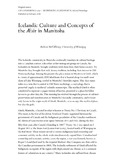Icelandic Culture and Concepts of the Æsir in Manitoba
Metadata
Show full item recordAuthor
McGillivray, Andrew
Date
2017Citation
McGillivray, Andrew. "Icelandic Culture and Concepts of the Æsir in Manitoba," CSS CONFERENCE 2017 — RETHINKING SCANDINAVIA, Selected Proceedings (Lund and Copenhagen: CSS Publications [Centre for Scandinavian Studies], 2017).
Abstract
The Icelandic community in Manitoba continually translates its cultural heritage into a Canadian context, a process that began in 1875 at the time of initial Icelandic settlement in the Interlake region. Like other settler groups in Canada, the Icelanders in Manitoba brought traditions with them from their home country. In this study on concepts of the Æsir (the Norse gods) in Manitoba, the author argues that the place name “Gimli” intentionally draws on a myth of exclusivity, framing the town site as a home for the pantheon of the North, or as a place set aside exclusively for the Icelanders who settled the area and their descendants. At the time of settlement this was the case, as people from other ethnicities were initially excluded from the land reserve, a policy upheld by the Canadian government for over two decades, but Gimli is now a multicultural municipality. Most significantly, Canadian colonial policy in the late-nineteenth century excluded the very people who had settled and used the lands of the Interlake for decades, even centuries, prior to European settlement of the region, the Indigenous peoples of the prairies and parklands. Now, in the twenty-first century, processes and strategies of colonial settlement are under critical evaluation, and this study contributes a localized interpretation of how place names and settlement myths play a role in the staking of claim and colonization of the North American northwest, and argues further that this process is still active.

